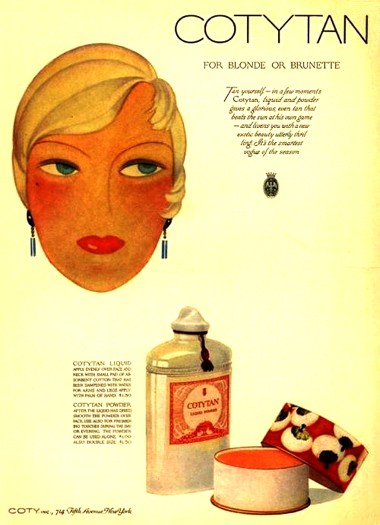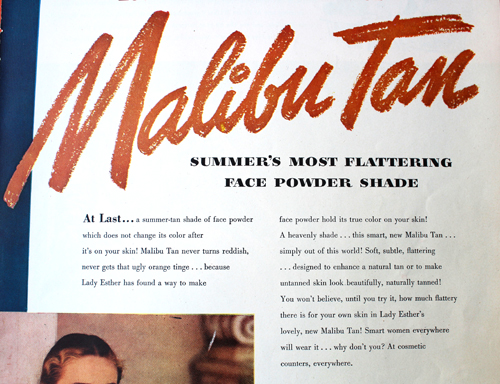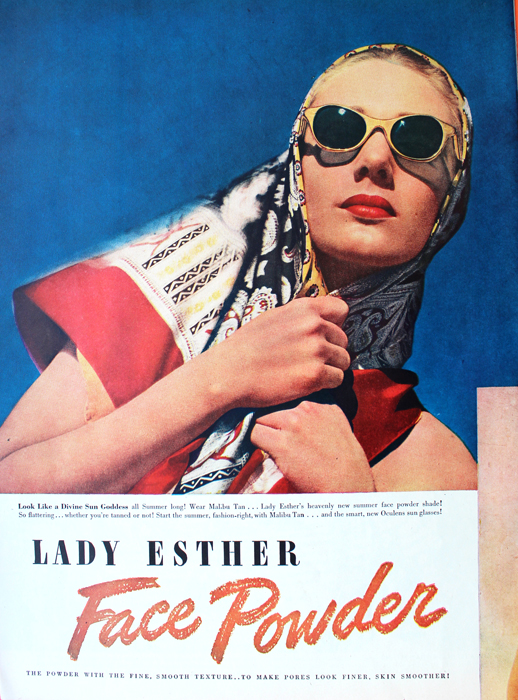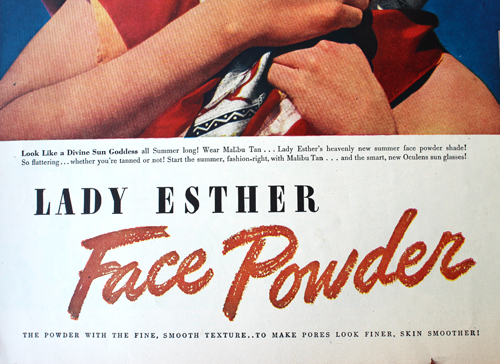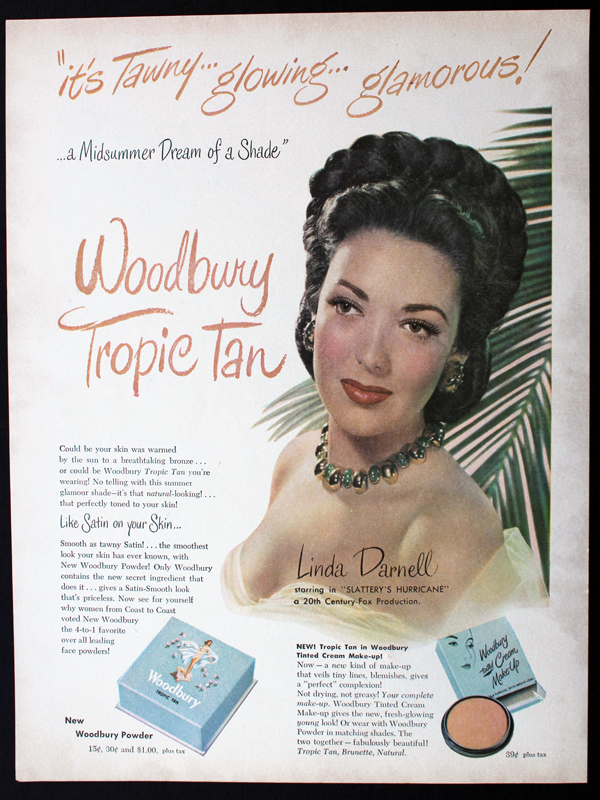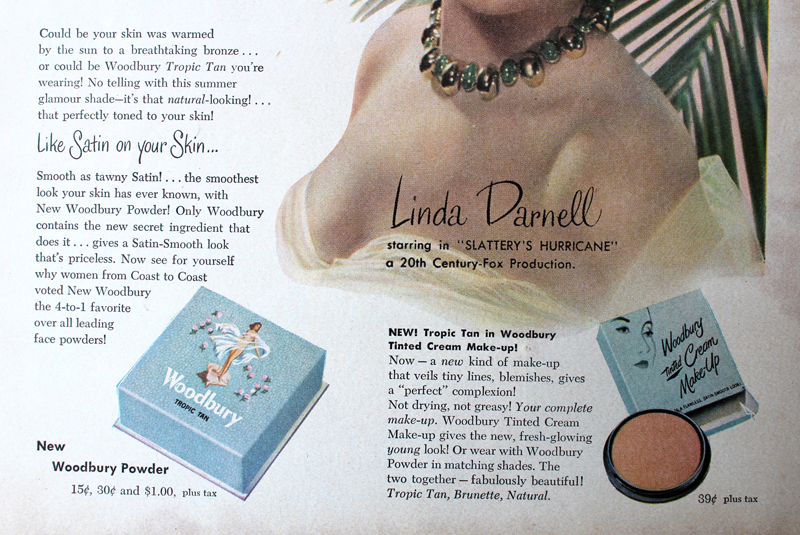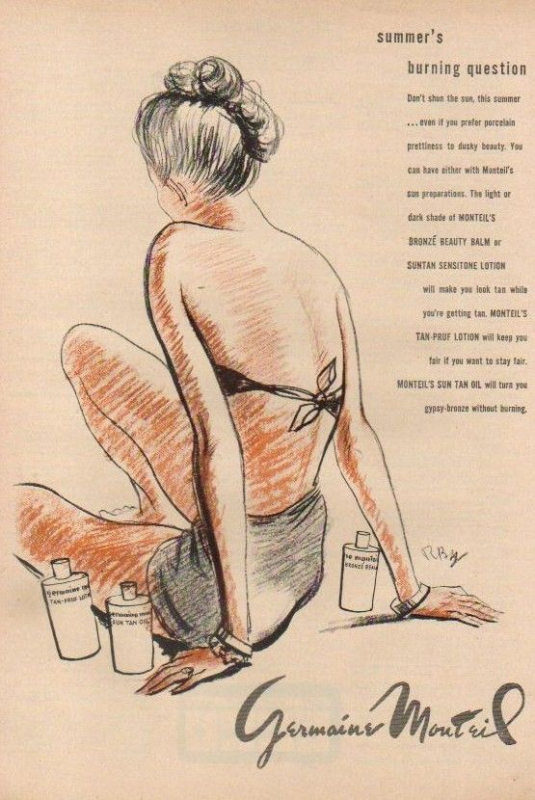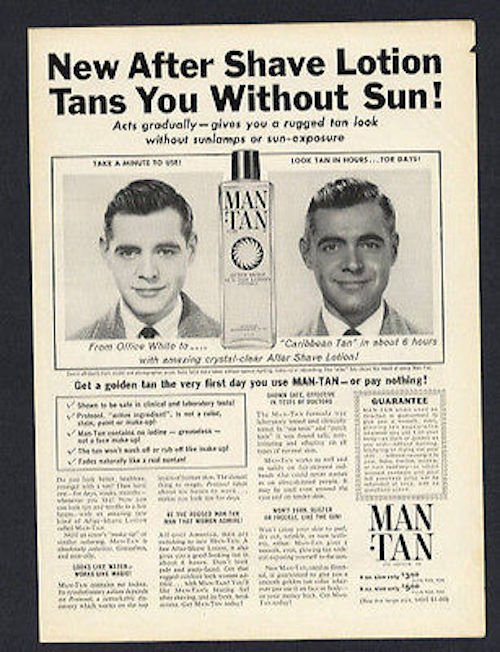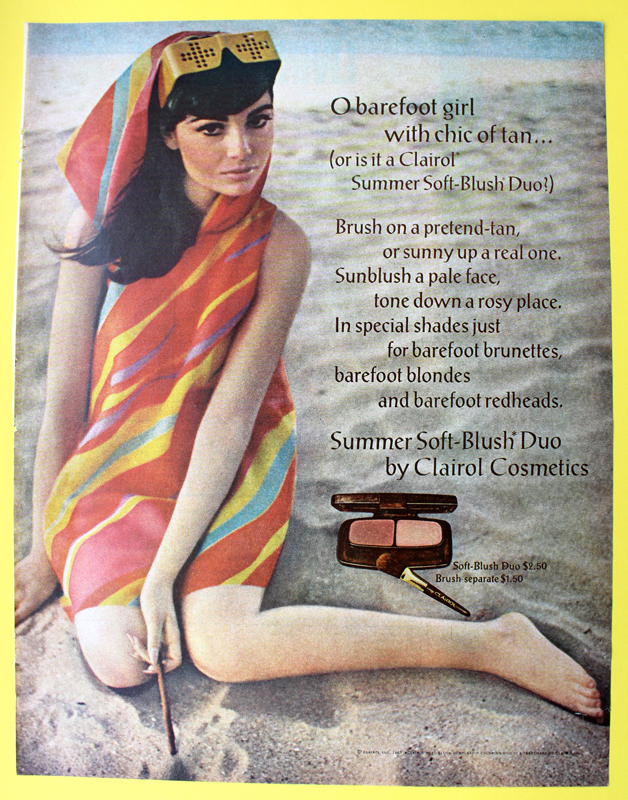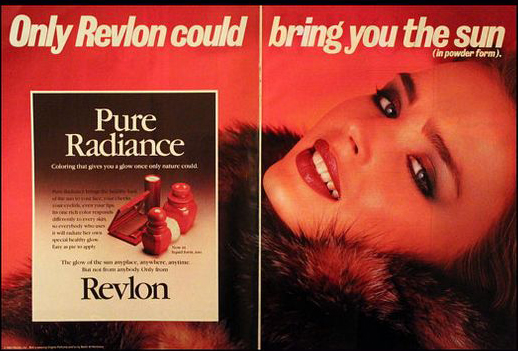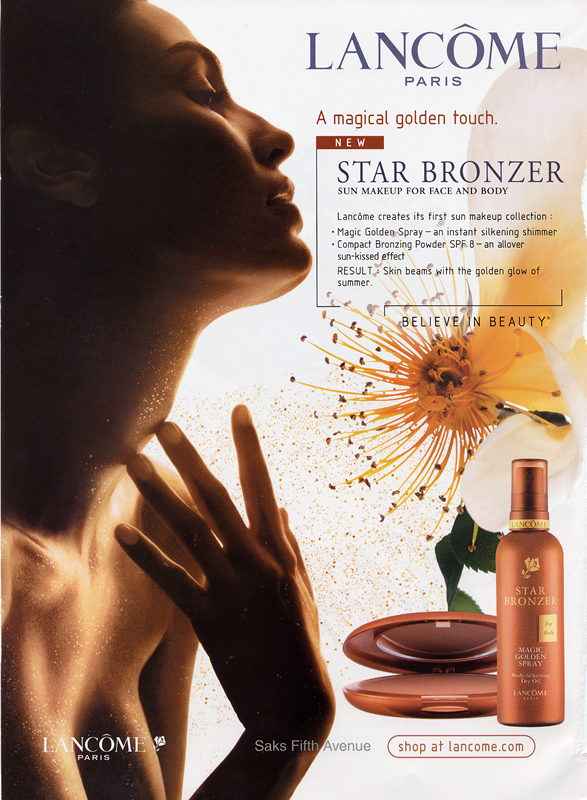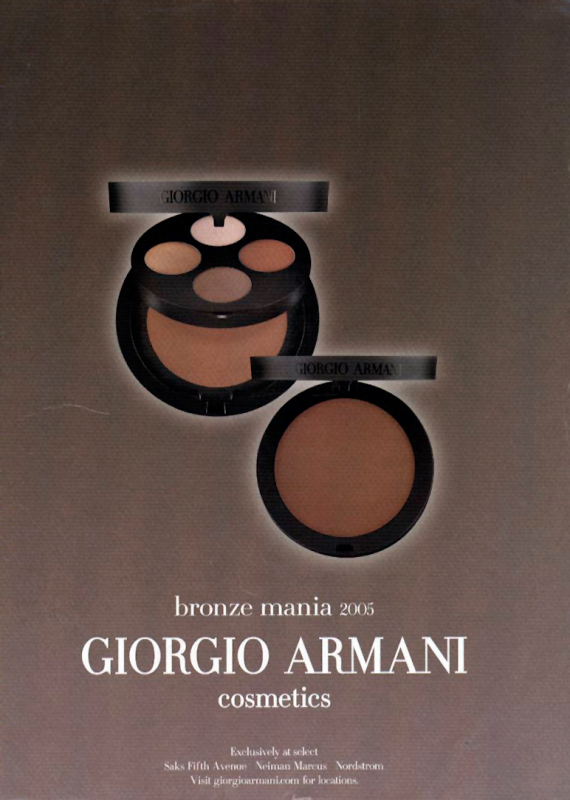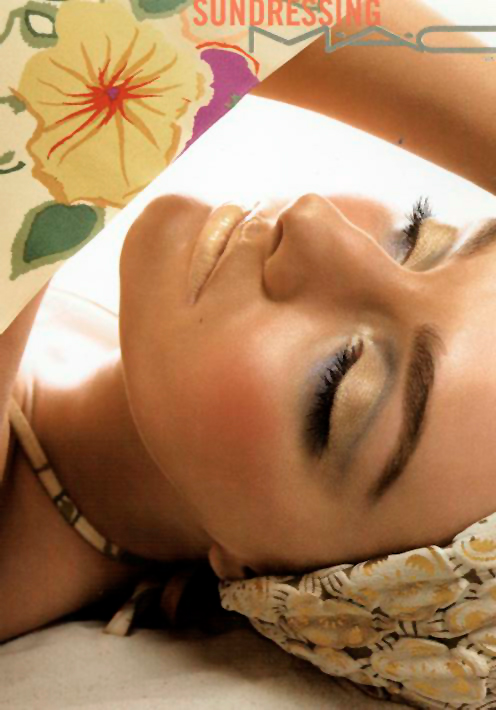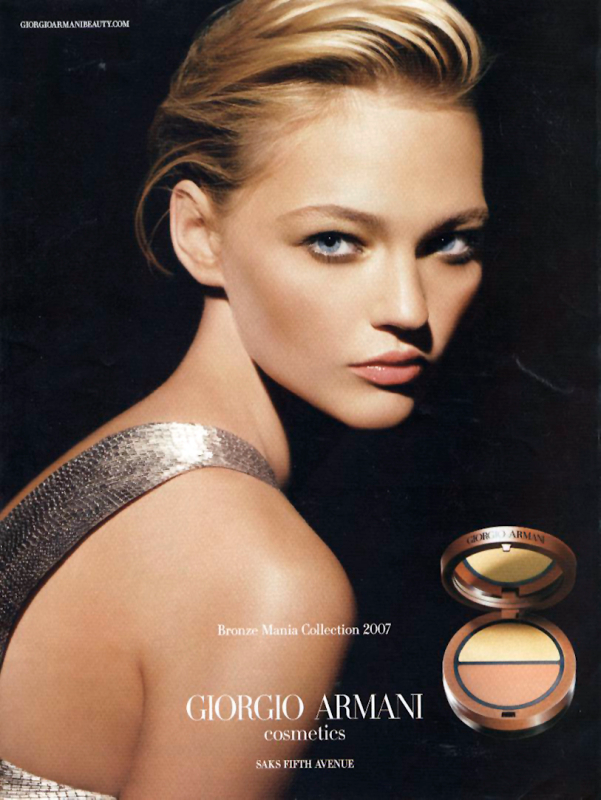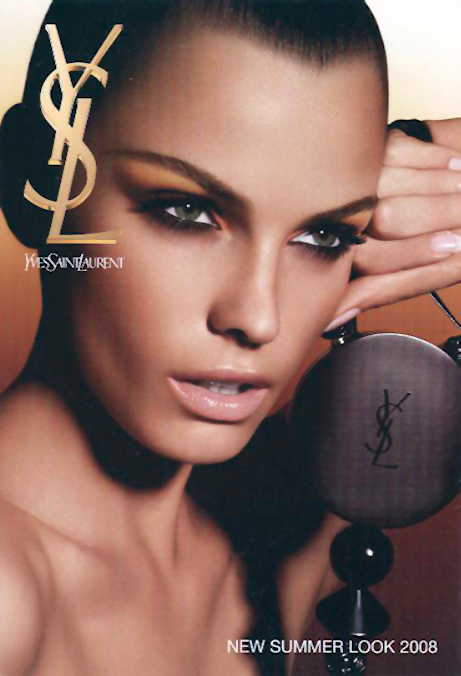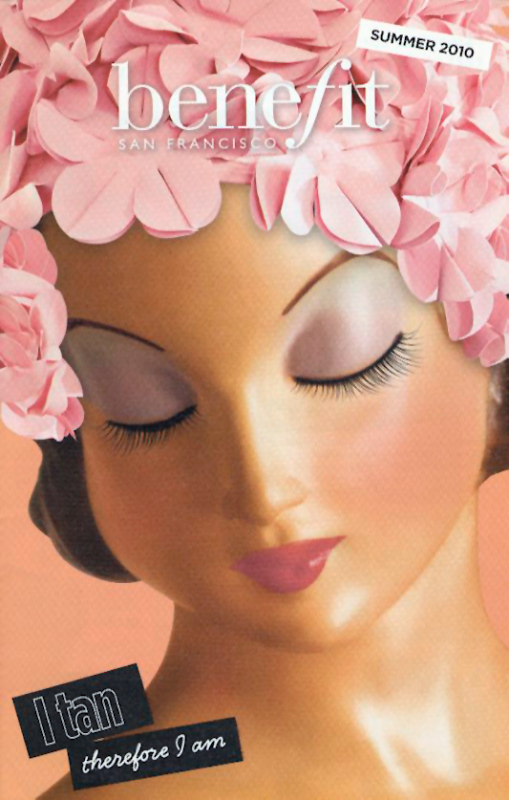I was originally going to write a meatier post about the history of tanning that included sunless tanning, but there's actually been plenty of research already. Rather than essentially re-writing what's already out there I decided to go the more visual route and show ads for products promising to give you that sun-kissed glow for both face and body. I will include some history and links throughout, but mostly this is a way for me to share my never-ending obsession with vintage beauty ads. :)
Prior to the early 1920s, having tawny, sun-drenched skin simply wasn't desirable – at least for women. Fair complexions were associated with the leisure class, while tan skin indicated a lower social status (i.e. people who had to work outdoors). While the beauty industry was in its infancy, there were still plenty of products, such as this Tan No More powder, that promoted the pale skin ideal.
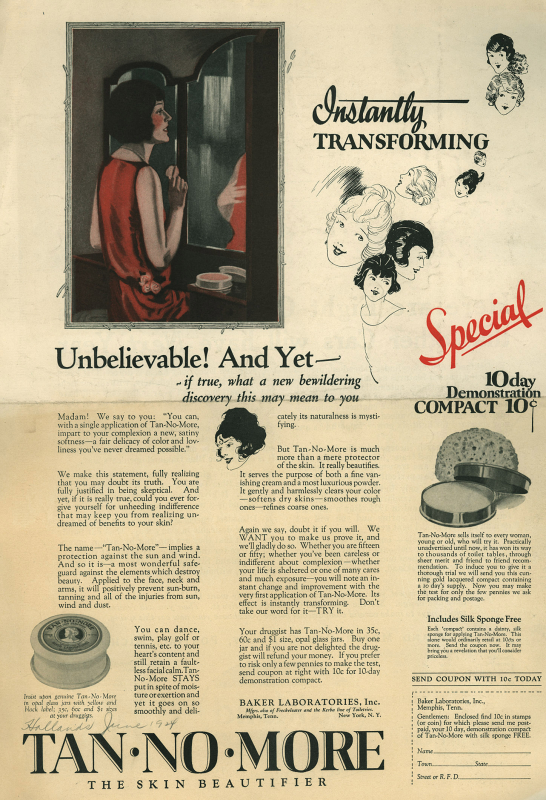 (image from library.duke.edu)
(image from library.duke.edu)
Just five short years later, however, the tan tide had turned. Coco Chanel is credited by many historians as the one responsible for making the bronzed look stylish following a cruise she took in 1923, essentially reversing the significance of pale vs. tan complexions (i.e., tans were now associated with having the time and money for a luxury vacation in a sunny paradise, as well as good health.) By 1929 products were on the market to achieve the glowing effect on the skin without the need to travel to some far-flung destination, such as this Marie Earle "Sunburn" line of makeup. (Cosmetics and Skin has an excellent history of this company. While not much is known about the founders, the Marie Earle line had some fairly innovative, if ineffective products, like breast-firming cream and eye masks.)
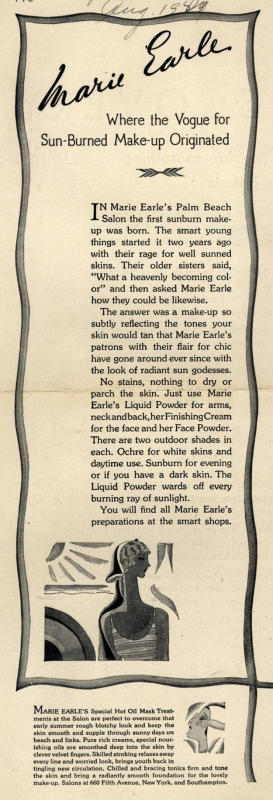
(image from library.duke.edu)
Interestingly, in 1928 Marie Earle was bought by Coty, so it's probably not a coincidence that Coty released their Coty Tan bronzing powder and body makeup a year later.
 (images from cosmeticsandskin.com and library.duke.edu)
(images from cosmeticsandskin.com and library.duke.edu)
The 1940s saw an increase in the number of bronzers and tanning body makeup, the latter influenced partially by the shortage of nylon stockings during World War II – women resorted to painting their legs with makeup or staining them with a tea-based concoction to create the illusion of stockings. Always looking to sell more products, companies soon began offering tinted body makeup to mimic a natural tan.
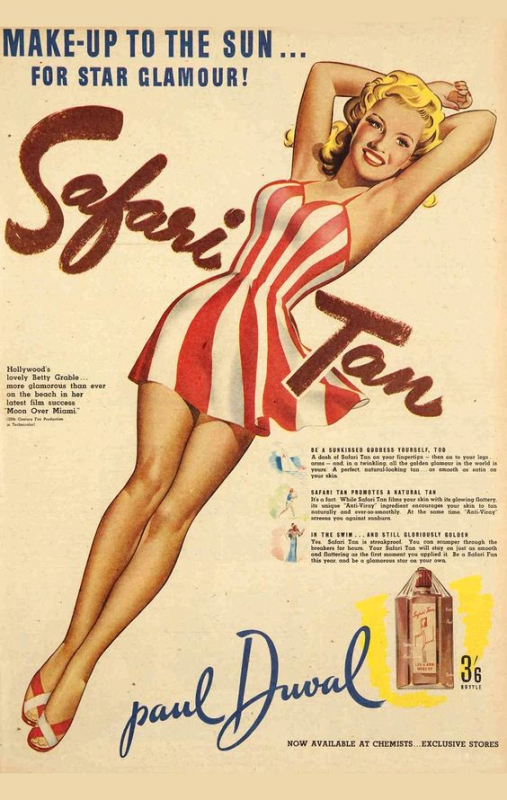 (image from pinterest.com)
(image from pinterest.com)
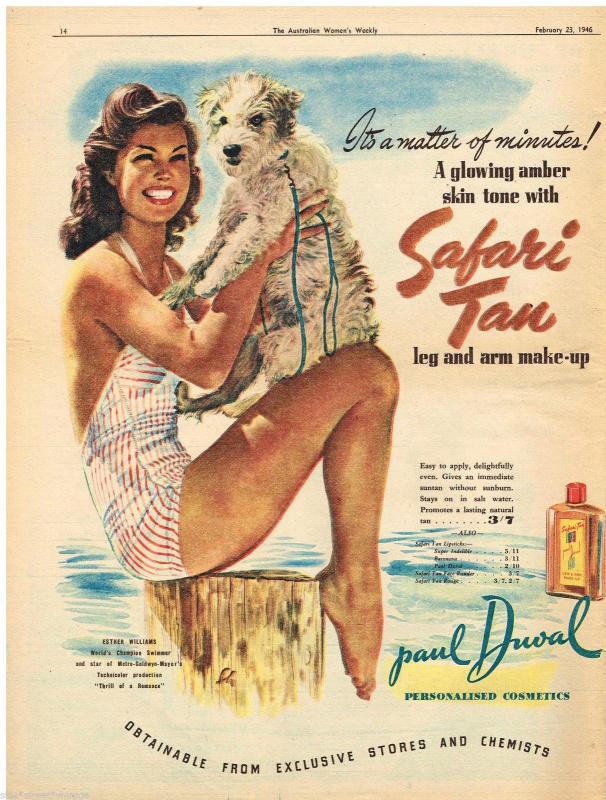 (image from ebay.com)
(image from ebay.com)
Um…would you like a side of racism with your liquid body bronzer?
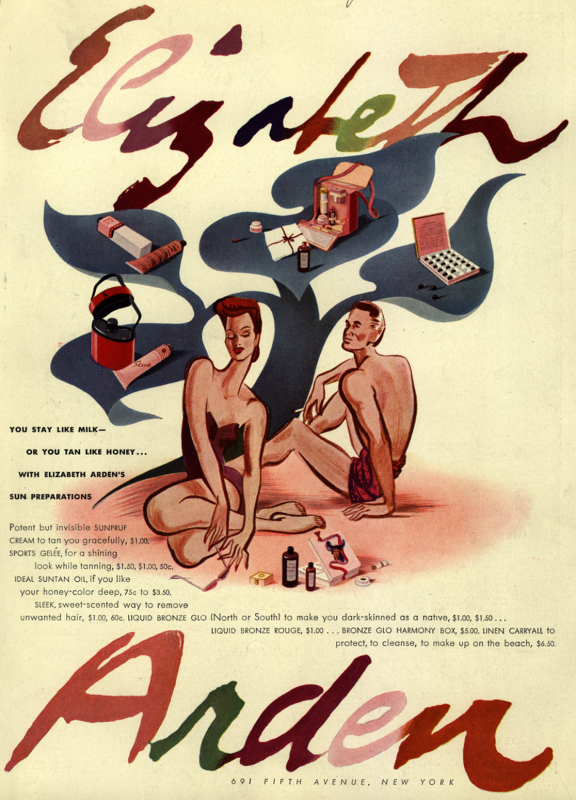 (image from library.duke.edu)
(image from library.duke.edu)
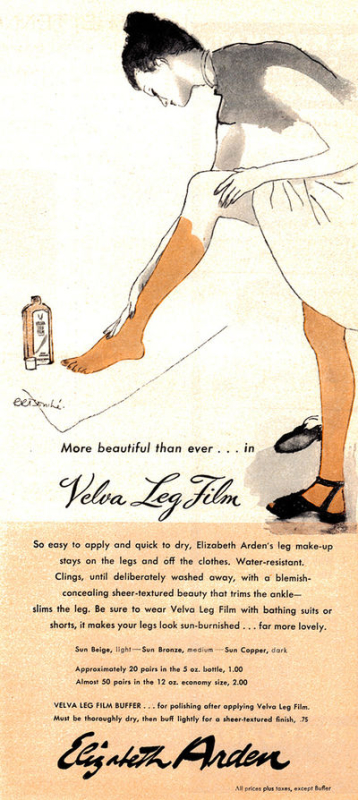
(image from Found in Mom's Basement)
 (image from ebay.com)
(image from ebay.com)
By the late '40s cosmetics companies made sure women could also artificially tan their faces, as a slew of bronzing powders entered the market. I couldn't resist purchasing a few of these ads.
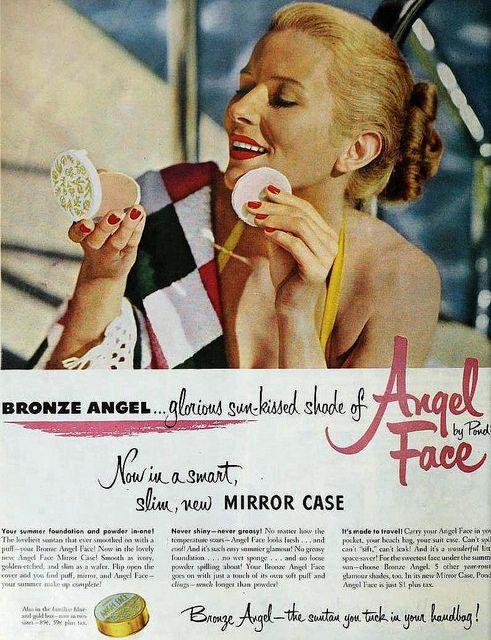
(image from pinterest.com)
Here's a detailed shot so you can see the ad copy…and gratuitous cleavage. LOL.
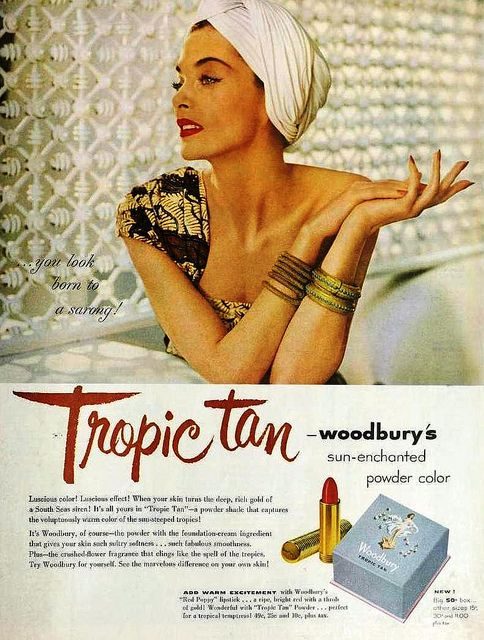
(image from pinterest.com)
And more casual racism from Germaine Monteil.
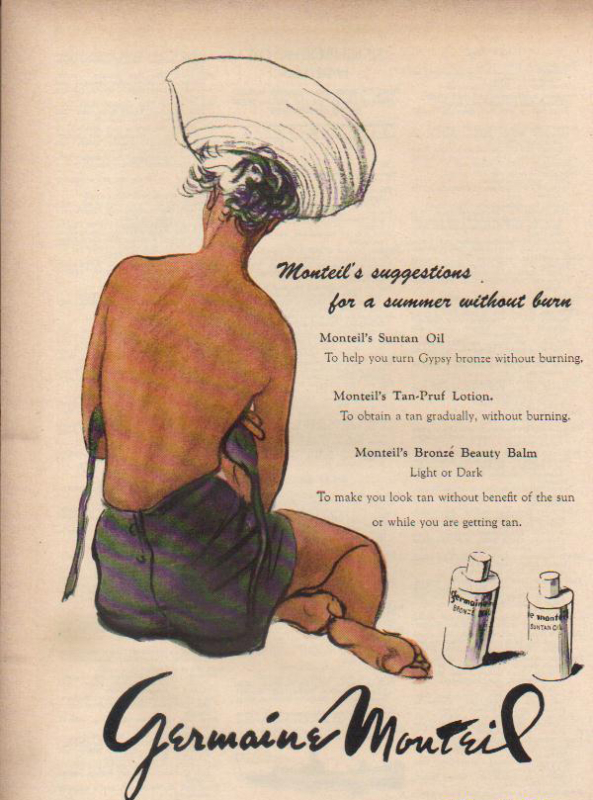 (image from ebay.com)
(image from ebay.com)
Once again, I fell victim to the idea that a beauty product has only been around for a few decades. But it looks like spray tans have been around since at least the mid-50s!
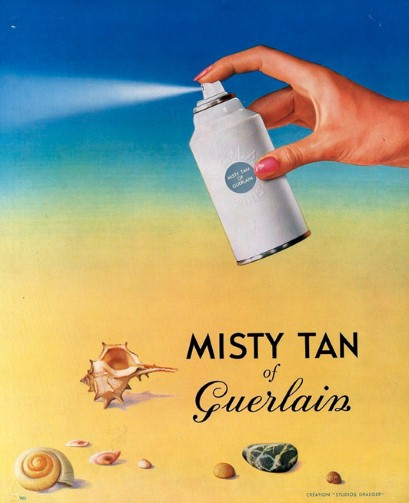
(image from fashion.telegraph.co.uk)
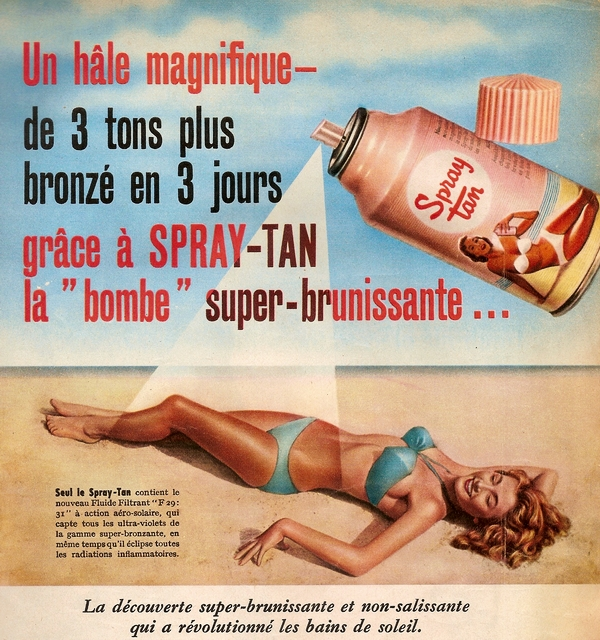 (image from Found in Mom's Basement)
(image from Found in Mom's Basement)
In the late 1950s Man Tan sunless tanning lotion – or what we call self-tanner more commonly these days – debuted, featuring a new way of getting tan without the sun. Instead of traditional tinted makeup that merely covered the skin, Man Tan used an ingredient known as dihydroxyacetone (DHA), which works on the amino acids on the skin's surface to gradually darken its color. It sounds like a harmful, scary process that relies on synthetic chemicals, but DHA is actually derived from sugar cane and is still used in most self-tanners today.*

(images from twitter and pinterest)
In 1960 Coppertone introduced QT, short for Quick Tan, and many others followed. The poor models in these ads already look orange – I shudder to think of how carrot-like you'd be in person.
 (image from ebay.com)
(image from ebay.com)
 (image from pinterest.com)
(image from pinterest.com)
You MUST watch these commercials, they're a hoot!
In addition to bronzers, around this time companies were also launching color campaigns specifically for tanned skin. These shades aren't so different from the ones we see in today's summer makeup collections – warm, beige and bronze tones abound. Both Max Factor's Breezy Peach and 3 Little Bares (get it?!) were seemingly created to complement a tawny complexion, while Clairol's powder duos and Corn Silk's Tan Fans line offered bronzer and blush together to artificially prolong and enhance a natural tan.
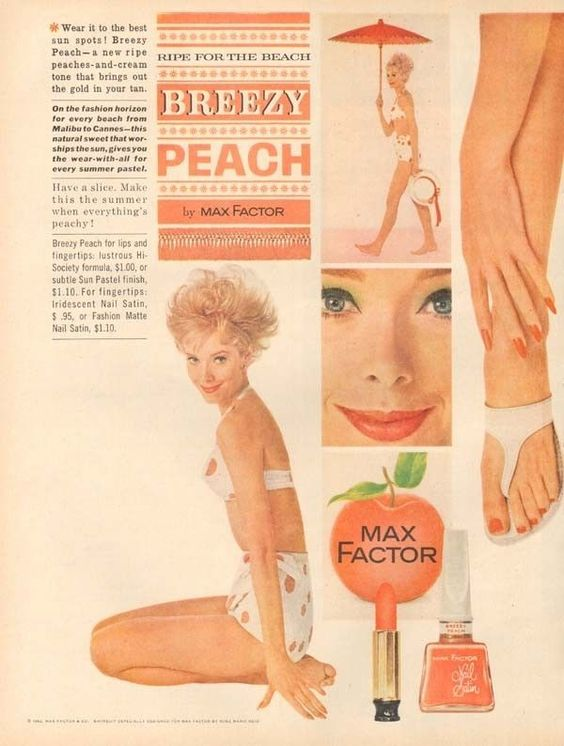 (image from pinterest.com)
(image from pinterest.com)
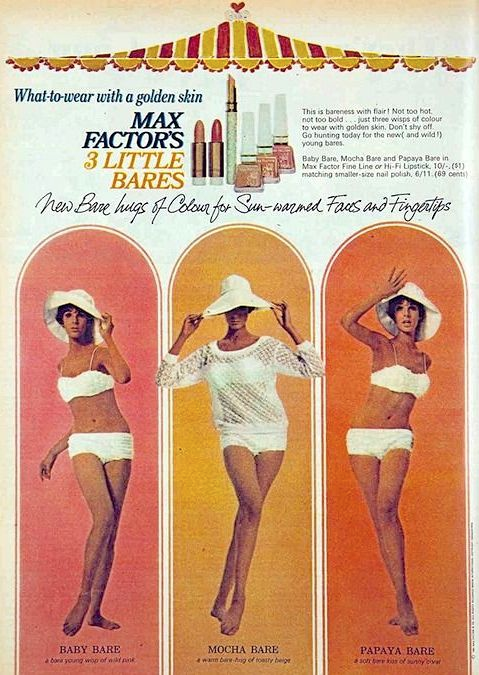
(image from pinterest.com)
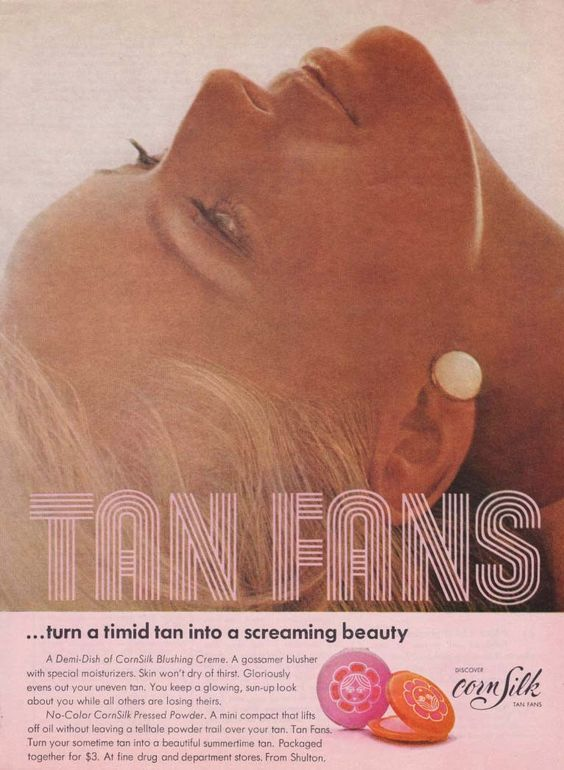 (image from pinterest.com)
(image from pinterest.com)
Meanwhile, Dorothy Gray had tan-flattering lip colors covered. This was not new territory for them, as this 1936 ad referenced a new "smart lipstick to accent sun-tan". In any case, the 1965 ad is also notable for the yellow lipstick all the way on right, which was meant to brighten another lip color when layered underneath…over 50 years before Estée Edit's Lip Flip and YSL's Undercoat.
 (image from mid-centurylove.tumblr.com)
(image from mid-centurylove.tumblr.com)
The tanning craze wasn't going anywhere soon, as various self-tanning and bronzer formulas for body and face continued to be produced from the '70s onward. As skin cancer rates rose, there was also an uptick in the number of ads that emphasized protection from the sun over the convenience angle (i.e., the ability to get a tan in just a few hours and no matter the climate) – self-tanners started to be marketed more heavily as a healthy alternative to a real tan.
When it launched around 2004, I thought Stila's Sun Gel was such an innovative product. Little did I know Almay had done it roughly 30 years prior.
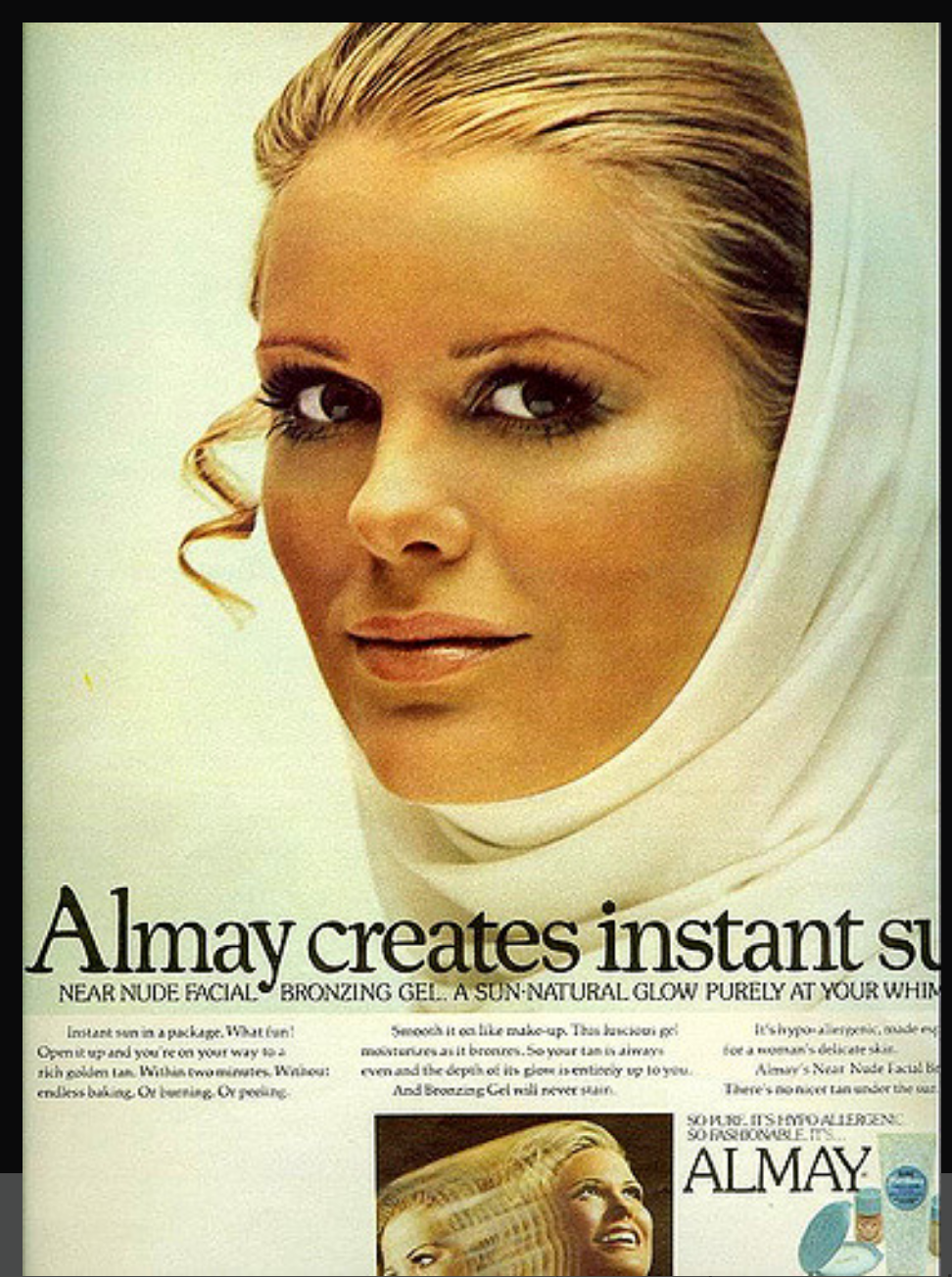 (image from flickr.com)
(image from flickr.com)
Tried though I did, I was unable to find a vintage ad for Guerlain's legendary Terracotta bronzer, which debuted in 1984. So I had to settle for these Revlon ads from the same year.
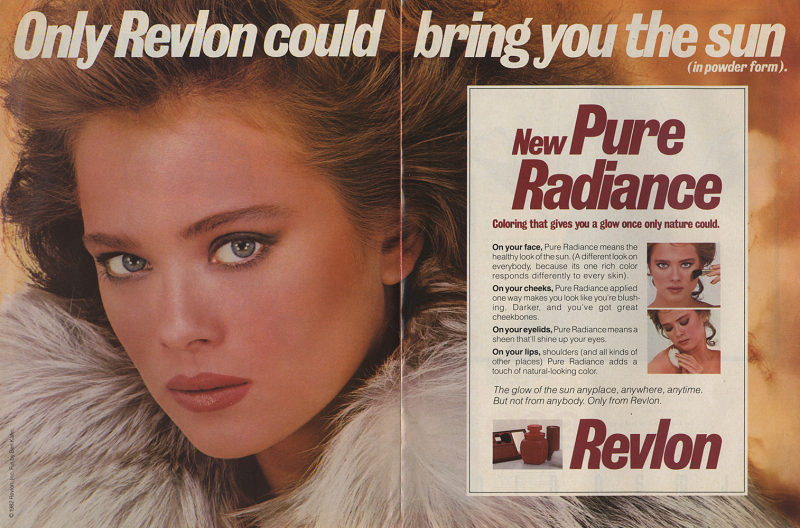 (images from pinterest and adsausage.com)
(images from pinterest and adsausage.com)
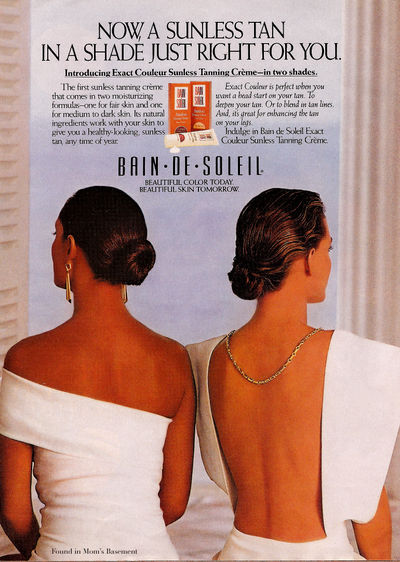
(image from Found in Mom's Basement)
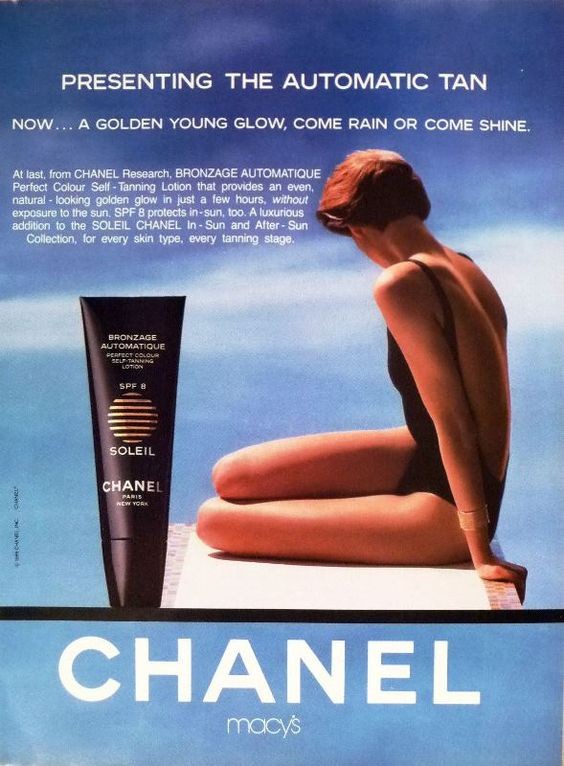
(image from pinterest.com)
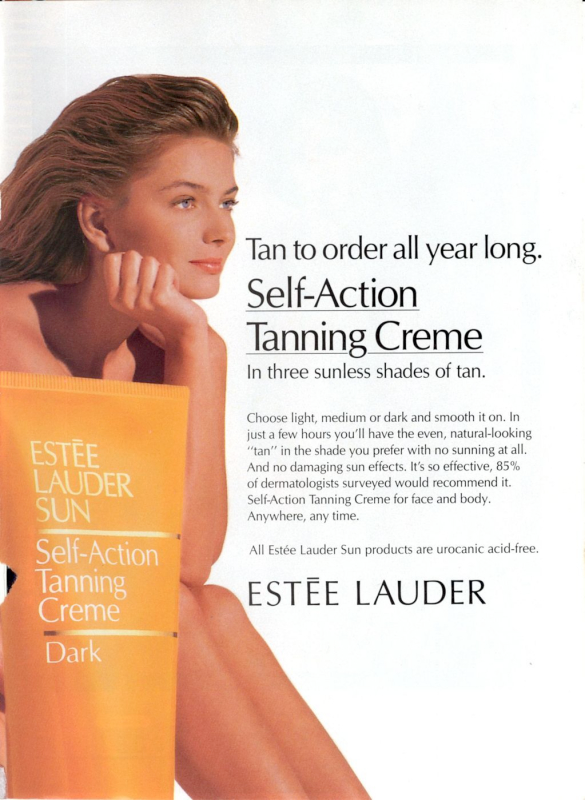 (image from fuckyeahnostalgicbeauty)
(image from fuckyeahnostalgicbeauty)
I searched all the '90s magazines in the Museum's archives, but realized almost all of them were March, September or October issues, so I couldn't unearth any fake tan ads for most of the decade. I did have better luck with finding ads online and in the Museum's archives for the 2000's, however. It makes sense as I had started collecting by then, not to mention that the early-mid aughts were the Gisele Bundchen/Paris Hilton era so fake tanning was at its peak. I just remembered that I neglected to check my old Sephora catalogs…I'll have to see if I can locate any photos of Scott Barnes' Body Bling, another hugely popular product in the 2000's.
(images from reed.edu)
Here are the ones from the Museum's collection. Thanks to the husband for scanning them!
Love this Armani ad, which coincidentally came out the same year Mystic Tan spray booths were launched.
As the decade came to a close, there was some discussion as to whether tanned skin, real or fake, was passé. But the continuing growth of the self-tanning market (as well as the influence of the bronzed Jersey Shore cast) showed that the infatuation with tanning wasn't slowing down. The Paris Hilton era segued seamlessly into the Kardashian age, which also contributed to the popularity of the bronzed look. Companies are still trying to keep up with the demand for bronzers and self-tanners. For the past 5 years or so, Estée Lauder, Lancome, Clarins, Guerlain and Givenchy have released new bronzing compacts at the start of the summer, and just this past year Hourglass and Becca released a range of new bronzing powders. Meanwhile, established products like Benefit's Hoola bronzer and St. Tropez's self-tanning line are being tweaked and expanded.
In terms of advertising bronzers and self-tanners, I think cosmetics companies do a damn good job. The products themselves certainly look tempting, but one also can't deny the sex appeal of the glowy, bronzey look of the models (not to mention that a tan makes everyone look like they lost 10 lbs). Who doesn't want to resemble a sunkissed goddess lounging about in a tropical paradise? It's largely this reason, I think, that the tan aesthetic persists. As usual, Autumn Whitefield-Madrano offers an insightful exploration of why tawny skin continues to be in vogue so rather than me rambling further I highly encourage you to read it in full. As for me, well, I've largely given up on self-tanning. It was messy, came out uneven no matter how much I exfoliated and how carefully I applied it, and still didn't look quite like the real deal. I do, however, still use bronzer once in a while (mostly as blush, but occasionally in the summer I'll dust it all over my face) and have been tinkering with temporary wash-off body bronzers. I don't consider bronzer a staple by any means – most days I fully embrace my pasty self – but the fact that I own 6 of them is proof of the long-standing allure of the tan and how effectively the products required to achieve it are marketed.
What do you think? Which of these ads are your favorite? And are you down with the tanned look or no?
*Recent research has shown DHA to be safe for topical use; however, inhaling it, say, from a spray tan booth, is less safe.


